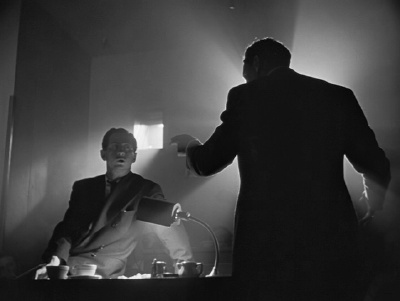Finally the moment came to watch the Citizen Kane disc that I’ve had for a while. But I hadn’t seen it entirely since junior high. A number of years ago I tried watch it on PBS, but they kept interrupting it for a pledge drive… this is not a movie that is well interrupted. It is certainly a fine movie and it seemed much shorter and more involving than I remember.
Citizen Kane has a lot going for it: a great cast, great production, a great and involving story… But the cinematography is really what grabs. The composition of the shots is really incredible with some intriguing camera angles and sets reminiscent of the expressionist era and some wonderful uses of lighting and smoke and shadows, which combine to instill a noirish sense of atmosphere. It even uses some conventions that really grab your attention, such as not showing the face of the actor speaking, instead obscuring the face with smoke or filming the character from behind. Welles also includes nice uses of deep focus that, at times, made me feel like I was watching an optical illusion. Some of these scenes really change ones perception of the scene and ones involvement with the story. It feels both like an ideal film of the period, and yet well ahead of its time. Not only is it a wonderful and grand film, but the fact that Welles was 25 when the co-wrote/directed and starred in this film makes it all the most astounding!
For the action itself, Orson Welles owns the scenes, but the film also features some strong supporters, including the wonderful Joseph Cotton in his first feature film role and even a brief time with Ray Collins (Lieutenant Tragg)!
Kane is the the story of a young boy whose mother becomes suddenly rich and it is sort of a composite of the life of Orson Welles and the life of William Randolph Hearst. His parents die and he grows into a freewheeling trust fund kid (whose trust fund is the words 6th largest fortune) who decides that it would be fun to run a little newspaper that he happens to own. He turns the newspaper into a muckraking political organ for the “little guy” and as its success expand and his wealth and fame expand, he falls into politics and basically grows up into just another lonely and conservative old rich man, living in a cold and failed palace of hope for a happiness and contentment that just isn’t there. The film is played out after Kane’s death as the story of a journalist seeking out the remaining people who knew him in an attempt to decipher the meaning of Kane’s last word.
The set also includes The Battle Over Citizen Kane, a companion documentary that was quite good. It is more a joint biography of Welles and Hearst, and it really showcases how blatantly based on Heart the movie was. Welles co-writer was someone quite familiar with Hearst who knew him and had spent time at San Simeon, which really shows.

the screening room

the screening room 2
